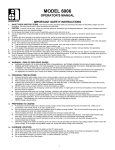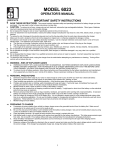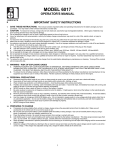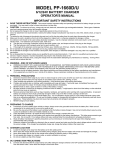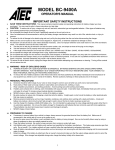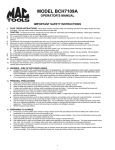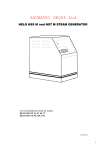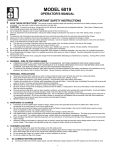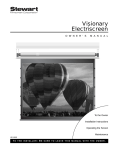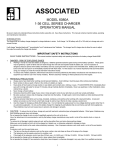Download Associated Equipment 6012 Battery Charger User Manual
Transcript
MODEL 6012 OPERATOR'S MANUAL ASSOCIATED 1. IMPORTANT SAFETY INSTRUCTIONS SAVE THESE INSTRUCTIONS. This manual contains important safety and operating instructions for battery charger you have purchased. You ma a later date. 2. 3. 4. 5. 6. 7. CAUTION. To reduce risk of injury, charge only wet cell, lead-acid, automotive type rechargeable batteries. Other types of batteries may burst causing Do not expose the charger to rain or snow if specifically warned on the unit not to do so. Use of an attachment not recommended or sold by the battery charger manufacturer may result in a risk of fire, electric shock, or injury to persons. To reduce the risk of damage to the electric plug and cord, pull by the plug rather than the cord when disconnecting the charger. Make sure the cord is located so that it will not be stepped on, tripped over, or otherwise subjected to damage or stress. An extension cord should not be used unless absolutely necessary. Use of a improper extension cord could result in a risk of fire and electric shock. If an a. That the pins on the plug of extension cord are the same number, size, and shape as those of the plug on the charger; b. That the extension cord is properly wired and in good condition; and c. If the length of the extension cord is less than 25 feet, use a 16AWG cord, If 50 feet- 12AWG, 100 feet-10AWG, 150 feet-8AWG. 8. Do not operate the charger with a damaged cord or plug, replace them immediately. 9. Do not operate the charger if it has received a sharp blow, been dropped, or otherwise damaged in any way; take it to a qualified serviceman. 10. Do not disassemble the charger; take it to a qualified serviceman when service or repair is required. Incorrect reassembly may result in risk of electric sho 11. To reduce the risk of electric shock, unplug the charger form the outlet before attempting any maintenance or cleaning. Turning off the controls will not red 12. WARNING - RISK OF EXPLOSIVE GASES a. WORKING IN VICINITY OF A LEAD-ACID BATTERY IS DANGEROUS. BATTERIES GENERATE EXPLOSIVE GASES DURING NORMAL BATTERY OPERAT OF UTMOST IMPORTANCE THAT EACH TIME BEFORE USING YOUR CHARGER, YOU READ THIS MANUAL AND FOLLOW THE INSTRUCTIONS EXACT b. To reduce the risk of battery explosion, follow these instructions and those published by the battery manufacturer and manufacturer of any equipment cautionary markings on these products and on the engine. 13. PERSONAL PRECAUTIONS a. Someone should be within range of your voice or close enough to come to your aid when you work near a lead-acid battery. b. Have plenty of fresh water and soap nearby in case battery acid contacts skin, clothing, or eyes. c. Wear complete eye protection, and clothing protection. Avoid touching eyes while working near battery. d. If battery acid contacts skin or clothing, wash immediately with soap and water. If acid enter eyes, immediately flood eyes with running cold water for immediately. e. NEVER smoke or allow a spark or flame in vicinity of the battery or engine. f. Be extra cautious to reduce risk of dropping a metal tool onto the battery. It might spark or short circuit the battery or other electrical parts that may ca g. Remove personal metal items such as rings, bracelets, necklaces, and watches when working with a lead-acid battery. A lead-acid battery can prod or the like to metal, causing a severe burn. h. Use this charger for charging a LEAD-ACID battery only. It is not intended to supply power to a low-voltage electrical system other than in an automot charging dry-cell batteries that are commonly used with home appliances. These batteries may burst and cause injury to persons and damage to prop I. NEVER charge a frozen battery. 14. PREPARING TO CHARGE a. If necessary to remove battery from vehicle to charge, always remove the grounded terminal from the battery first. Make sure all accessories in the b. Be sure the area around the battery is well ventilated while the battery is being charged. Gas can be forcefully blown away by using a piece of cardb c. Clean the battery terminals. Be careful to keep corrosion from coming in contact with eyes. d. Add distilled water in each cell until battery acid reaches level specified by the battery manufacturer. This helps purge excessive gas from cells. Do follow the manufacturer's recharging instructions. e. Study all battery manufacturer's specific precautions such as removing or not removing the cell caps while charging and the recommended rates of ch f. Determine voltage of the battery by referring to the car owner's manual and make sure that the output voltage selector switch is set at the correct volt charge the battery initially at the lowest rate. 1 15. CHARGER LOCATION a. Locate the charger as far away from the battery as the DC cables permit. b. Never place the charger directly above the battery being charged; gases from the battery will corrode and damage the charger. c. Never allow battery acid to drop on the charger when reading the specific gravity or filling battery, d. Do not operate the charger in a closed-in area, or restrict ventilation in any way. e. Do not set a battery on top of the charger. 16. DC CONNECTION PRECAUTIONS a. Connect and disconnect the DC output clamps only after setting the charger switches to the OFF position and removing the AC cord from the electric o b. Attach the DC clamps to the battery post and twist or rock back and forth several times to make a good connection. This tends to keep the clamps fro of sparking. 17. FOLLOW THESE STEPS WHEN THE BATTERY IS INSTALLED IN A VEHICLE. A SPARK NEAR THE BATTERY MAY CAUSE A BATTERY EXPLOSION. TO REDUCE THE RISK OF A SPARK NEAR THE BATTERY: a. b. c. d. e. f. g. h. Position the AC and DC cords to reduce the risk of damage by the hood, door, or moving engine parts. Stay clear of fan blades, belts, pulleys, and other parts that can cause injury to persons. Check the polarity of the battery post. The POSITIVE (POS, P, +) battery post usually has a larger diameter than the NEGATIVE (NEG, N, -) post. Determine which post of the battery is grounded (connected) to the chassis. If the negative post is grounded to the chassis (as in most vehicles), see chassis, see item "f". For negative-grounded vehicles, connect the POSITIVE (RED) clamp from the battery charger to the POSITIVE (POS, P, +) ungrounded post of the batte the vehicle chassis, heavy gauge metal part of the frame, or engine block, away from the battery. Do not connect to the carburetor, fuel lines, or shee For positive-grounded vehicles, Connect the NEGATIVE (BLACK) clamp from the battery charger to the NEGATIVE (NEG, N, -) ungrounded post of the the vehicle chassis or engine block away from the battery. Do not connect the clamp to the carburetor, fuel lines, or sheet-metal body parts. When disconnecting the charger, turn the switches to OFF, disconnect the AC cord, remove the clamp from the vehicle chassis, and then remove the See the operating instructions for length of charge information. 18. FOLLOW THESE STEPS WHEN THE BATTERY IS OUTSIDE THE VEHICLE. A SPARK NEAR THE BATTERY MAY CAUSE BATTERY EXPLOSION. TO REDUCE THE RISK OF A SPARK NEAR THE BATTERY: a. b. c. d. e. f. g. Check the polarity of the battery post. The POSITIVE (POS, P, +) usually has a larger diameter than the NEGATIVE (NEG, N, -) post. Attach at least a 24 inch long 6-gauge (AWG) insulated battery cable to the NEGATIVE (NEG, N, -) battery post. Connect the POSITIVE (RED) charger clamp to the POSITIVE (POS, P, +) post of the battery. Position yourself and the free end of the cable as far away from the battery as possible, then connect the NEGATIVE (BLACK) charger clamp to the f Do not face the battery when making the final connection. When disconnecting the charger, always do so in reverse sequence of connecting procedure, and break the first connection while standing as far aw A marine (boat) battery must be removed and charged on shore. To charge it on board requires equipment specially designed for marine use. 19. GROUNDING AND AC POWER CORD CONNECTION INSTRUCTIONS The charger should be grounded to reduce the risk of electric shock. This charger is equipped with an electric cord having an equipment grounding conduc plugged into an outlet that is properly installed and grounded in accordance with all local codes and ordinances. DANGER. Never alter the AC cord or plug provided - if it will not fit the outlet, have a proper outlet installed by a qualified electrician. Improper connectio battery charger is for use on a nominal 120-volt circuit, and has a grounding plug that looks like the plug illustrated in FIGURE (A). A temporary adapter, whic may be used to connect this plug to a two-pole receptacle, as shown in FIGURE (B), until a properly grounded outlet can be installed by a qualified electricia DANGER. Before using an adapter as illustrated, be certain that the center screw of the outlet plate is grounded. The green-colored rigid ear or lug exte properly grounded outlet - make certain it is grounded. If necessary, replace the original outlet cover plate screw with a longer screw that will secure the a ground connection to grounded outlet. NOTE: USE OF AN ADAPTER IS NOT ALLOWED IN CANADA. IF A GROUNDING TYPE RECEPTACLE IS NOT AVAILABLE, DO NOT USE THIS APPLIANCE U IS INSTALLED BY A QUALIFIED ELECTRICIAN. 2 20. LENGTH OF CHARGE a. Test the battery for state of charge. Do not charge if it is over 75% charged or the battery is determined to be defective. b. Set beginning amps charge rate for size of battery and state of charge per charts c. Charge for length of time per charge, d. Discontinue charge when the specific gravity of electrolyte reaches 1.260 or above. A temperature compensating hydrometer should be used for this gas excessively or when the temperature of the electrolyte reaches approximately 120EF. Do not overcharge batteries. Overcharging results in exc ASSEMBLY INSTRUCTIONS 1. 2. 3. Remove the screws from the back of charger and attach the handle in an upright position with screws provided. Remove the four screws on the bottom toward the front of the charger and attach the leg with the screws provided. Put one of the axle nut on one side of the axle by tapping the nut on with a hammer. Then slide the axle through one of the wheels and then through the hol in the charger until it comes out the other end. Put the other wheel and axle nut on. OPERATING INSTRUCTIONS CAUTION - This battery charger must be fully assembled before operating. Failure to do so may result in risk of injury. USE OF INSTRUMENT PANEL: The MINUTES CHARGE timer has an OFF position, a CONTINUOUS CHARGE position and a timed charge range from 0 to 90 minutes. a. OFF - Always make sure the timer is in the OFF position before connecting or disconnecting the clamps from the battery. The charger will not charge with the timer in this position. b. CONTINUOUS CHARGE - This position is used for slow charging or parallel charging, the timer will not shut the charger OFF while in this position. Do not use this position for fast charging. c. 0 to 90 MINUTES TIMED CHARGE - The timer will automatically turn the charger off at the end of the pre-set charging time. Turn the timer past 20 before setting the desired time. TO CHARGE BATTERIES Make the connections to the battery per the instructions in the previous sections. Determine if the battery is 6 or 12 volts. Set the CHARGE VOLTAGE switch to 6/12 LOW CHARGE for a 6 or 12 volt battery. If higher rate is desired, set at 12 MED. or 12 HIGH. DO NOT charge a 6 volt battery at setting other than 6/12 low.(Damage may occur to the battery.) Turn the timer on and the Ammeter will show the amount of current delivered to the battery. Length of charge should be per the above chart and instructions. 12 VOLT CRANK ASSIST STARTING Turn off all lights and accessories in the stalled vehicle. Connect the charger to battery per previous instructions. Charge the battery on 12 HI for at least five minutes before attempting to start the vehicle. Put the switch in the 12 CRANK ASSIST position. Start the vehicle with the charger connected to the battery. Follow the duty cycle on the unit. NOTE: Do not crank the engine more than 20 seconds in any five minute period; excessive cranking may overheat and damage the starter. If the vehicle fails to charger to continue to charge the battery. Turn the switch to OFF and remove the AC power cord from the electric outlet before disconnecting the DC clamps. 3 CHARGING SULFATED BATTERIES If your battery has sat in the discharged state for an extended period of time, it can become SULFATED. This usually is seen as a white deposit near the top of water levels remains discharged for an extended time. Sulfated batteries exhibit the characteristic of accepting no charge regardless of the rate of charge. The charging method is two staged. The first stage of attempting to break down the sulfation to allow the battery to accept a charge must be closely watched t charge and overheating. The second stage is a slow charging to restore the battery to full charge. READ AND FOLLOW ALL PRECAUTIONS AND WARNINGS IN YOUR INSTRUCTION MANUAL BEFORE ATTEMPTING TO CHARGE SULFATED BATTERIES. FAILUR WARNINGS MAY RESULT IN PROPERTY DAMAGE OR SERIOUS PERSONAL INJURY OR DEATH. To recharge a sulfated battery: 1. Attach the battery clamps as described in the instruction manual. 2. Always use the chargers lowest rate when turning the charger on. Set the charger to the chargers highest rate for the voltage of the battery being ch CAUTION: NEVER CHARGE A BATTERY AT VOLTAGES RATES ABOVE THAT OF THE BATTERY. 3. The battery will show little or no amperage at the start of the charging process. This will continue until the sulfation begins to break down. CAUTION: AS THE SULFATION BREAKS DOWN, THE AMPERAGE MAY RAPIDLY RISE. CONSTANT ATTENTION MUST BE OBSERVED TO PREVENT SERIOUS OVERHEATING OF THE BATTERY. 4. 5. NOTE: Lower the charge rate to the lowest rate for the voltage of battery being charged. Charge the battery at this low rate until the electrolyte reaches the fully charged state as described in the tables in your instruction manual. This may SOME BATTERIES MAY BE SO BADLY SULFATED THEY CAN NOT BE RESTORED TO A NORMAL OPERATING CONDITION, REGARDLESS OF THE RAT LENGTH OF TIME THE CHARGE IS APPLIED. IF THE BATTERY CANNOT BE RESTORED TO A FULLY CHARGED CONDITION BY A SLOW CHARGING, IT WIRING DIAGRAM MODEL 6012 REPAIR PARTS LIST Timer w/knob . . . . . . . . . . . . . . . . . . . 610895 Switch w/knob . . . . . . . . . . . . . . . . . . 605675 Axle w/nuts . . . . . . . . . . . . . . . . . . . . 610052 Wheels w/nuts . . . . . . . . . . . . . . . . . . 605672 Clamps . . . . . . . . . . . . . . . . . . . . . . . . . . 6199 Jaw Kit . . . . . . . . . . . . . . . . . . . . . . . . 610970 Transformer . . . . . . . . . . . . . . . . . . . . Rectifier . . . . . . . . . . . . . . . . . . . . . . . Fan Blade . . . . . . . . . . . . . . . . . . . . . . Fan Motor . . . . . . . . . . . . . . . . . . . . . . Leg . . . . . . . . . . . . . . . . . . . . . . . . . . . DC Circuit Breaker . . . . . . . . . . . . . . . 610819 610364 610189 610190 605671 610536 Amps Meter . . . . . . . . . . . . . . . . . . . . AC Cord . . . . . . . . . . . . . . . . . . . . . . . DC Cable Set . . . . . . . . . . . . . . . . . . . . Handle . . . . . . . . . . . . . . . . . . . . . . . . . AC Breaker . . . . . . . . . . . . . . . . . . . . . 605204 610696 610820 605213 603597 Parts may be purchased from your local authorized service depot listed in the Service Procedure manual supplied with your product. If you elect to order parts f order from the factory is $25.00. Orders received that are under the minimum will not be processed. Taxes and freight are extra and are not considered to be p C.O.D. policy. Cashier check, Money order, Mastercard or VISA are acceptable. If you use a Mastercard or VISA send only the number and expiration. DO NOT MAINTENANCE INSTRUCTIONS Worn clamps should be replaced. Worn parts can lead to poor connections and present a safety hazard. See parts list for part number of DC Cable Set. Any Maintenance or repair of this unit that involves disassembly of the cabinet should be done only by a qualified serviceman. Incorrect reassembly may result used. 4 6012 ENGLISH MANUAL ILLUSTRATION LISTING 27-582E.MAN FIG. 1 2 3 4 5 FILE NAME DESCRIPTION LOGO.EPS ASSOCIATED LOGO PLUG-ENG.PLTGROUNDING ADAPTER -ENGLISH ENGLSTBL.PLTCHARGE RATE TABLE - ENGLISH 6012.PLT 6012 CABINET 27-582WE.PLT6012 WIRING DIAGRAM - ENGLISH 5





